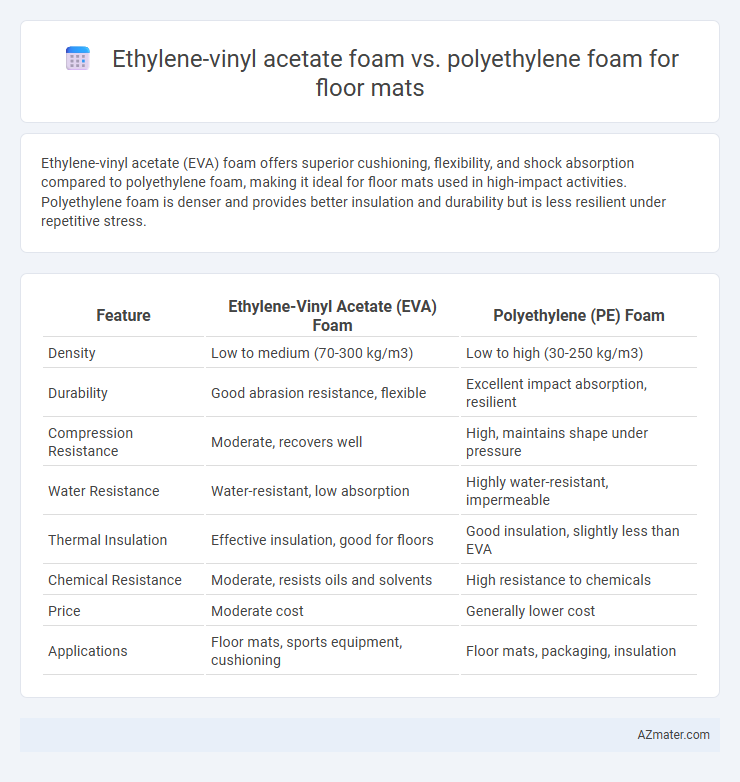Ethylene-vinyl acetate (EVA) foam offers superior cushioning, flexibility, and shock absorption compared to polyethylene foam, making it ideal for floor mats used in high-impact activities. Polyethylene foam is denser and provides better insulation and durability but is less resilient under repetitive stress.
Table of Comparison
| Feature | Ethylene-Vinyl Acetate (EVA) Foam | Polyethylene (PE) Foam |
|---|---|---|
| Density | Low to medium (70-300 kg/m3) | Low to high (30-250 kg/m3) |
| Durability | Good abrasion resistance, flexible | Excellent impact absorption, resilient |
| Compression Resistance | Moderate, recovers well | High, maintains shape under pressure |
| Water Resistance | Water-resistant, low absorption | Highly water-resistant, impermeable |
| Thermal Insulation | Effective insulation, good for floors | Good insulation, slightly less than EVA |
| Chemical Resistance | Moderate, resists oils and solvents | High resistance to chemicals |
| Price | Moderate cost | Generally lower cost |
| Applications | Floor mats, sports equipment, cushioning | Floor mats, packaging, insulation |
Introduction to EVA Foam and PE Foam
Ethylene-vinyl acetate (EVA) foam offers excellent cushioning, flexibility, and resilience, making it a popular choice for floor mats in fitness, play, and industrial settings. Polyethylene (PE) foam is known for its lightweight, closed-cell structure that provides superior impact absorption and moisture resistance, ideal for durable and water-resistant floor mats. Both EVA and PE foams provide thermal insulation and comfort, but EVA foam typically offers softer support while PE foam delivers higher density and enhanced durability.
Material Composition and Properties
Ethylene-vinyl acetate (EVA) foam consists of a copolymer of ethylene and vinyl acetate, offering excellent elasticity, shock absorption, and resistance to UV radiation, making it ideal for floor mats requiring cushioning and durability. Polyethylene (PE) foam is composed of low-density or closed-cell polyethylene, providing high compressive strength, moisture resistance, and thermal insulation but with less flexibility compared to EVA. EVA foam's softer texture and enhanced flexibility deliver superior comfort and support for prolonged standing, while PE foam excels in impact resistance and longevity under heavy use.
Durability and Longevity Comparison
Ethylene-vinyl acetate (EVA) foam offers superior durability and resistance to cracking, making it ideal for long-lasting floor mats under heavy foot traffic. Polyethylene (PE) foam provides good cushioning but tends to degrade faster with repeated compression and exposure to moisture, reducing its longevity. EVA foam's enhanced elasticity and abrasion resistance contribute to extended lifespan and sustained performance compared to PE foam in floor mat applications.
Cushioning and Comfort Levels
Ethylene-vinyl acetate (EVA) foam offers superior cushioning and shock absorption compared to polyethylene (PE) foam, making it ideal for floor mats that require enhanced comfort during prolonged use. EVA foam's closed-cell structure provides excellent resilience and softness, reducing foot fatigue and joint stress effectively. In contrast, PE foam is denser and firmer, delivering less cushioning but better durability and compression resistance, suitable for heavy-duty applications where support is prioritized over comfort.
Shock Absorption Capabilities
Ethylene-vinyl acetate (EVA) foam offers superior shock absorption capabilities compared to polyethylene (PE) foam, making it ideal for floor mats where impact protection is crucial. EVA foam's closed-cell structure and flexibility enable efficient energy dispersion, reducing stress on joints and minimizing injury risk during high-impact activities. In contrast, PE foam provides firmer support with less cushioning, resulting in lower shock absorption performance.
Water Resistance and Moisture Management
Ethylene-vinyl acetate (EVA) foam offers superior water resistance compared to polyethylene foam, making it less prone to water absorption and ideal for floor mats in damp environments. Its closed-cell structure prevents moisture infiltration, reducing the risk of mold and mildew growth. Polyethylene foam, while also water-resistant, tends to have a more open-cell structure, which can allow limited moisture retention and slower drying times.
Slip Resistance and Safety Features
Ethylene-vinyl acetate (EVA) foam provides superior slip resistance for floor mats due to its closed-cell structure and high elasticity, which enhances grip and reduces the risk of slipping. Polyethylene (PE) foam, though durable and shock-absorbent, typically offers less traction as its surface is smoother and less flexible compared to EVA. Safety features in EVA mats include better energy absorption and impact protection, making them ideal for environments requiring enhanced slip resistance and cushioning.
Environmental Impact and Sustainability
Ethylene-vinyl acetate (EVA) foam and polyethylene (PE) foam differ significantly in environmental impact and sustainability, with EVA foam offering better durability and resistance to UV radiation, reducing replacement frequency and waste generation. EVA foam is partially recyclable and can be produced with lower greenhouse gas emissions compared to PE foam, which is derived from non-renewable petroleum sources and less biodegradable. Sustainable floor mats prioritize EVA foam for its improved long-term environmental footprint and potential for eco-friendly manufacturing processes.
Cost Efficiency and Value for Money
Ethylene-vinyl acetate (EVA) foam offers superior durability and cushioning compared to polyethylene (PE) foam, often justifying a slightly higher upfront cost with enhanced lifespan and comfort. PE foam is typically more affordable initially but may compress faster and degrade sooner, leading to more frequent replacements and higher long-term costs. Considering cost efficiency and value for money, EVA foam provides better overall investment for floor mats due to its balance of resilience, shock absorption, and longevity.
Best Use Cases: EVA vs PE Floor Mats
Ethylene-vinyl acetate (EVA) foam floor mats excel in shock absorption, flexibility, and durability, making them ideal for exercise, yoga, and playroom settings where comfort and impact resistance are crucial. Polyethylene (PE) foam mats offer superior water resistance, chemical stability, and compression resilience, which is advantageous for industrial, marine, or outdoor environments requiring durability against moisture and wear. Choosing EVA mats supports high-impact activities, while PE mats are better suited for heavy-duty, moisture-prone applications.

Infographic: Ethylene-vinyl acetate foam vs Polyethylene foam for Floor mat
 azmater.com
azmater.com